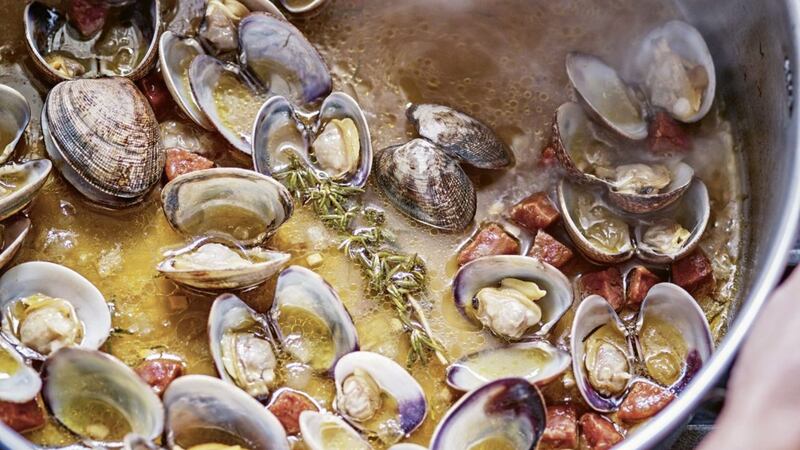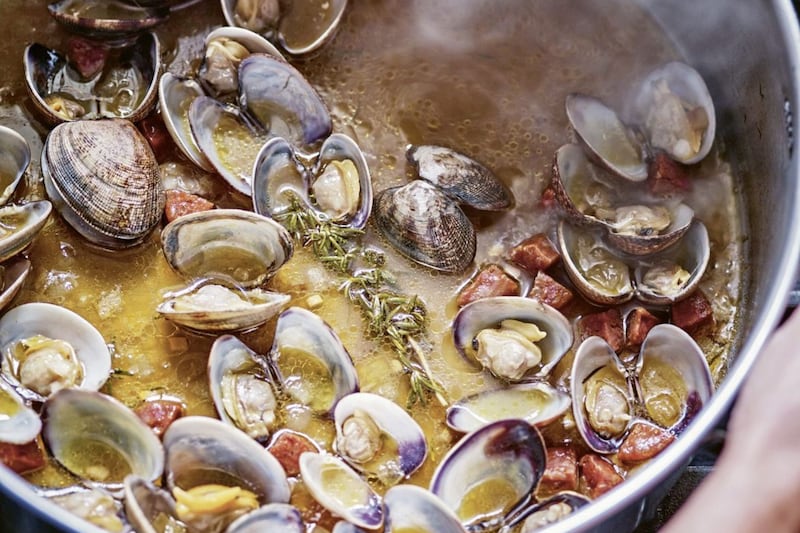THERE is seemingly too much gazpacho as we sit down at chef Jose Pizarro's dining table, at his south London home. He's already doled out bowlfuls of the cool, strawberry and tomato soup – the muted, velvety red of geraniums spiked with a powerful, peppery vinegar that we knock back teaspoons of – to his staff, who have spent the morning wandering in and out of his kitchen, snagging bits of croissant, letting him know that a new sherry supplier has been in touch.
There's still one bowlful left. A movement is made to take it away, but he grabs it with a grin: "For my lunch!"
We're having 'gazpacho elevenses' in honour of Pizarro's latest cookbook, Andalusia, which coincides with the Spanish restaurateur's 20th year living in Britain.
It's summer encapsulated in print, from the simplest of recipes, like his orange and oregano salad, to espeto (barbecued sardines) and apricot sorbet with tejas dulces de Sevilla (thin, crunchy almond biscuits).
But he does not want to hear that it is too beautiful to use: "Please, cook, make it dirty, ruin it and send it to me – I will send you a new one."
There wasn't much Spanish food available when Pizarro first moved to London, mostly high-street chain fare, and "people didn't know what they were eating", he recalls. And what they were eating "wasn't related to Spanish quality and ingredients", either.
Take olive oil, he says, mock-horrified, it was something you kept in the medicine cabinet: "They thought olive oil was to clean their ears – you go to the pharmacy and buy olive oil – the most horrible olive oil ever. Rancid, disgusting, and the most expensive olive oil you'll buy in your life."
Things have changed a lot in two decades though, and the concept of good Spanish food is something most of us are largely comfortable with. "[Iberian] ham – people do understand now." Delving deeper into the food of Andalusia then, is not so obscure an idea as it might have been two decades ago.
Even some of the relaxed qualities of Spanish-style eating are translating, especially the idea of small sharing plates. "If you are in a tapas bar and you are there alone, you just sit next to someone," explains Pizarro. "[You] say, 'Oh wow, what's that?' [to the person next to you]. That opens a conversation.
"You feel more comfortable to do that in a place like a tapas bar, than other places."
It's a much more amiable way of eating than the traditional English way of saying, "That's mine – and don't ask me, 'How is the food?'," says Pizarro with a laugh, the image of someone leaning over with their own fork springing instantly to mind. "It's getting much better," he says of habits here. Things are loosening up.
Born in Extremadura in south west Spain, Pizarro moved to London after a stint cheffing in Madrid, and although "it was a shock" has "loved it since the beginning" – largely because of the diversity of food and cuisines available in Britain, a diversity Spain just didn't have.
"We're lucky now, we can go out every night if we want, we don't need to stay in, we don't need to spend so much money and you can eat OK," he says.
He's also found that people are increasingly keen to learn more – and so he's doing his best to make everyone a fan of sherry – drunk chilled and dry, a staple of southern Spain.
"Sherry is really important for me," he says. We don't indulge in a cold glass with our gazpacho, but if the hands on the clock had nudged a little further past 11am, we would have done. "It's not a granny drink that was in the cabinet, warm, from the year before. It brings much flavour."
Not that he doesn't have great respect for the tastes and expertise of women who have been cooking all their lives. While researching Andalusia, he visited las hermanas Franciscanas (the Franciscan nuns) in the town of Ronda in Malaga province.
"I went to the convent and I thought, 'I'm not going to get in'," remembers Pizarro; fortunately they grabbed and hugged him.
"So lovely! Oh they were really lovely, really friendly. In some way, they want to see people coming from outside, slowly, slowly, slowly, try to open a little bit more, not much I think, but enough to build a community and to share." They taught him how to make ganotes – twists of sweet, orange scented deep-fried dough – that he says is the most moving, touching recipe in the book for him.
However, turn to page 194 for a picture of Pizarro happily rolling out dough, and the nun next to him is looking at him utterly bemused. "That face," says Pizarro, creased up with laughter. "I'm very happy. She looking at me like, 'What are you doing?!'"
But "every recipe has a story", says Pizarro with feeling. "It has to have something that means something, or it's just food."
:: Andalusia: Recipes From Seville And Beyond by Jose Pizarro, photography by Emma Lee, is published by Hardie Grant, priced £26. Below are three recipes from the book for you to try at home.
STRAWBERRY GAZPACHO
(Serves 6)
300g vine-ripened tomatoes, chopped
700g ripe strawberries, with a few reserved for garnish
1 roasted red pepper, sliced
1 small shallot, finely chopped
1 small garlic clove, crushed
1tbsp sherry vinegar
75ml extra virgin olive oil, plus extra for drizzling
Sea salt and freshly ground black pepper
Olive oil, for frying
2 slices sourdough, diced
Basil leaves and edible flowers, to garnish
Method:
In a large bowl, combine all the ingredients except the olive oil, sourdough and garnishes and leave to infuse overnight. The next day, add the olive oil and whizz together with a hand blender or in a food processor until smooth, adding a splash of water if it's too thick. Season to taste.
Pour a little olive oil into a frying pan over a medium heat and fry the sourdough croutons for four to five minutes, until golden. Drain on kitchen paper and sprinkle with sea salt.
Divide the gazpacho between individual soup bowls and garnish with basil leaves, edible flowers and croutons. Finish with a drizzle of extra-virgin olive oil and some sea salt. Serve with a cold glass of sherry, preferably amontillado or palo cortado.
CLAMS WITH CHORIZO
(Serves 4)
1kg clams
75g chorizo picante, chopped into 1cm cubes
1tbsp extra-virgin olive oil
1 small onion, finely chopped
1 garlic clove, finely chopped
Large sprig of thyme
100ml fino sherry
Method:
Place the clams in a bowl under cold running water for five minutes. Discard any that won't close.
In a lidded saucepan over a high heat, cook the chorizo in a little olive oil for six minutes, until caramelised. Using a slotted spoon, remove the chorizo from the pan and place in a bowl.
Add the onion, garlic and thyme sprig to the chorizo fat in the pan and fry for 10 minutes, or until softened. Increase the heat, add the clams and chorizo back to the pan, pour in the sherry, then cover with a lid. Cook for three minutes, or until all the clams have steamed open, discarding any clams that haven't.
Tip into a large bowl and serve with crusty bread to mop up the juices.
HONEY PASTRIES WITH BAKED FIGS
(Serves 10-12)
125g caster sugar
50ml honey
1/2tsp orange blossom water
225ml water
150g mixed nuts such as walnuts, almonds, pistachios, finely chopped
1/2tsp ground cinnamon
100g unsalted butter, melted
6-8 sheets of filo pastry
For the figs:
8 ripe figs, halved
Good drizzle of honey
4tbsp Pedro Ximenez sherry
Handful of flaked almonds, toasted
Method:
Preheat the oven to 180C. In a small saucepan, melt the sugar, honey and orange blossom water with the water, then simmer gently for 10-15 minutes, until slightly reduced and syrupy.
Mix the chopped nuts with the cinnamon. Lightly grease an 18-20cm square shallow tin with a little of the melted butter. Lay a sheet of filo in the bottom (trim if necessary) and brush with the butter, scatter with the nuts then add another layer of filo and melted butter.
Repeat four times, ending with a final layer of filo. Butter the top generously and use a sharp knife to cut into diamond shapes. Bake for 25-30 minutes, until golden and crisp.
Spoon half of the cooled syrup over the pastries as they come out of the oven. Let stand for five minutes, then spoon over the rest of the syrup. Allow to cool completely in the tin.
As the pastries are cooling, place the figs in a small baking dish and drizzle with honey and sherry. Bake in the oven for 15-20 minutes until tender. Serve the pastries with the baked figs and a dollop of creme fraiche, if you like.



